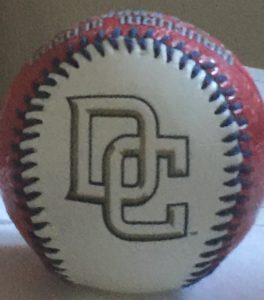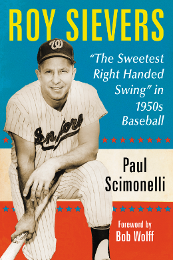October 30
Senator Managers
Clark Griffith, 1912-1920
Record as Senator Manager: 693-646, .518 Pct.
Teams Managed:
1912: 91-61 .599 Pct. 2nd
1913: 90-64 .584 Pct. 2nd
1914: 81-73 .526 Pct. 3rd
1915: 85-68 .556 Pct. 4th
1916: 76-77 .497 Pct. 7th
1917: 74-79 .484 Pct. 5th
1918: 72-56 .563 Pct. 3rd
1919: 56-84 .400 Pct. 7th
1920: 68-84 .447 Pct. 6thAlong with Ban Johnson and Charlie Comiskey, Clark Griffith was a major figure in getting the AL off the ground. As manager of Comiskey’s White Sox in 1901, the Pale Hose were the first AL champions. With Johnson’s persuasion, Griffith moved on to New York to lead the recently relocated Baltimore Orioles. As the Highlanders pilot, Griffith led the Highlanders to two second place finishes in 5 and a half seasons at the helm. Following his resignation in 1908, Griffith was rumored to be Washington bound with reports that Joe Cantillon was on his way out as the Nats manager. But the Senators improvement in 1908 prompted Thomas Noyes to keep Cantillon on board. Griffith, surprisingly, went to the National League to head Cincinnati for 3 years. Nonetheless, Griffith kept his eye on possible developments in Washington.
When Jimmy McAleer suddenly resigned after 1911, Noyes, a friend of Griffith, seized his chance to bring the Silver Fox to D.C. Not only was Griffith offered the Nats managerial position, but Noyes also sweetened the pot by allowing Griffith a chance to buy a half interest stock in the franchise. Griffith, seeing his old friends Johnson, Comiskey, as well as former teammate McAleer owning significant chunks of various franchises, longed to possess ownership himself. Griffith declined the Reds offer to return as their manager and mortgaged his ranch in Montana to come up with the funds to acquire the half interest in the Senators. On October 30, 1911, Griffith was formally announced as the Senators manager.
Immediately, the Senators on field fortunes turned for the better. Washington zoomed up to 2nd in 1912 thanks to Griffith’s early season purchase of Chick Gandil. The Senators peeled off an AL record 17 game win streak after Gandil’s arrival. Clyde Milan topped the league with 88 steals, Gandil hit at a .305 clip with 81 RBI and Walter Johnson‘s 33 wins catapulted the Senators to an impressive 91-61 record. Unfortunately, Noyes did not live to see the Senators turn around, having passed away in August. Griffith was rewarded with a seat on the board of directors.
It was more of the same in 1913. A second consecutive runner up finish, Gandil leading the team in batting at .318 and Milan’s 75 swipes again tops in the AL. The story of 1913 was Johnson. An incredible 36-7 mark, a 1.13 ERA, 11 shutouts and a 55.2 consecutive scoreless inning streak established the Big Train as, without a doubt, the best pitcher in all of baseball.
Hamstrung by the board of directors to improve an anemic offense, Griffith’s squad slid to 3rd place in 1914. Gandil’s production slipped to .259, prompting Griffith to hit the bushes in search of a replacement. Milan stole only 38 bags, but he led the team with a .295 average, indicative of the club’s offensive woes. If not for Johnson’s 28 wins, there is no telling how far the Senators would have fallen. An interesting side note to 1914 was the ML debut of Irish Meusel in a Washington uniform. The same Irish Meusel who would, 10 years later for the Giants, inexplicably not throw home as the winning run scored for the Senators in game 7 of the 1924 World Series.
Falling to 4th despite winning 4 more games than in the year before, the 1915 Senators would debut two key players to the Senator championship teams that would follow a decade later. The first was 1B Joe Judge, who would render Gandil expendable. Judge began his career with a torrid .415 BA, while Sam Rice pitched in 4 games before being converted to the outfield. Judge and Rice would be teammates for 16 seasons, a record not broken until Alan Trammel and Lou Whittaker played 17 seasons together in Detroit.
The rest of the decade, with the exception of the war shortened season of 1918, found Griffith and the Nats falling below the .500 mark. After a 56-84, 7th place debacle in 1919, many on the board wanted Griffith fired. The feeling was mutual as Griffith privately wished he could fire the entire board and only answer to himself. Since the Silver Fox could not obviously fire the board, he did the next best thing: Find someone favorable to Griffith to buy out the shareholders. Griffith convinced Philadelphia grain merchant William Richardson to purchase a majority ownership in the Senators. The generous Richardson consented to Griffith request that he (Griffith) be allowed to speak for Richardson. In other words the Silver Fox was the man in charge, with Richardson providing most of the money.
Running the franchise as he saw fit, Griffith returned to the dugout in 1920. Bogged down by administrative duties, scouting trips and other trappings of ownership, Griffith managed only a 68-84, 6th place finish. It did not help that Johnson, his first career no-hitter notwithstanding, was injured most of the year, posting an 8-10, 3.13 ERA ledger. Rice, Judge and Bucky Harris were bright spots, all hitting over .300. Milan hit .322, but the aging 33 year old stole only 10 bases. Realizing he had too much on his plate, Griffith relinquished his managerial duties after the season.
Senators Birthdays
Edward James Delahanty B Oct. 30, 1867 D Jul. 2, 1903
Hall Of Famer Ed Delahanty played 16 seasons, amassing 2596 hits in 1835 games, finishing with a .346 BA.
However, he seems to be most remembered for his mysterious death on July 2nd of 1903 after being put off a passenger train in Canada, somehow falling to his death in the Niagara River as the train was on its way to Buffalo. His death has been cause for much speculation and conjecture over the ensuing 105 years.
One of 5 brothers who all played professional baseball, Ed Delahanty‘s major league career began in late May of 1888 when he first appeared with the Philadelphia franchise, then known as the Quakers. In 74 games in his first season, Delahanty would only hit .228, splitting his time between 2nd base and the outfield. Delehanty would appear in just 56 games in 1889 but would raise his batting average to .293.
1890 found Delehanty with the Cleveland Infants of the short-lived Players League, playing in 115 games and hitting .296.
In 1891 Delehanty would be back in a Philadelphia uniform hitting .243 and establishing himself as an outfielder.
Delehanty would start displaying his hitting prowess in 1892, batting over .300 for the first time. He’d go on to hit over .300 in the next 12 seasons and would hit over .400 3 times-.407 in 1893, .404 in 1894 and .410 in 1899, when he’d lead the National League in hitting.
After the 1901 season, Delehanty would jump to the American League and the Washington Senators at 34 years of age. Hitting .376 in his first season in Washington, Delehanty would return in 1903 and would have a .333 BA at the time of his death.
An excellent writeup on the life, career and the events leading up to his untimely death can be found here:






